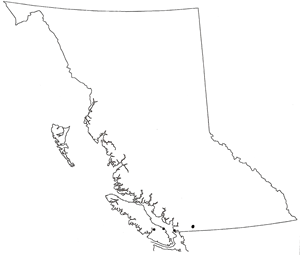This is an introduced European species of earthworm. Reynolds (1977) provides the following description for it: “Length, 30-50 mm (generally <35mm), diameter 3-5 mm, segment number 70-100, prostomium tanylobic, first dorsal pore 5/6-8/9. Clitellum xxviii-xxxiii. Tubercula pubertatis xxix-xxxii. Setae closely paired, AA ≅ BC, AB > CD, DD ≅ ½ C anteriorly and DD < ½C posteriorly. Setae a and b on ix and/or x on pale genital tumescences fused ventrally. Male pores inconspicuous on xv. Seminal vesicles, three pairs in 9, 11 and 12 + 13. Spermathecae, two pairs with short ducts in 9/10 and 10/11. Colour, deeply pigmented with dark red, chestnut, violet brown and strongly iridescent. Body cylindrical and dorsoventrally flattened posteriorly.”
Source: Reynolds, John W. 1977. The Earthworms (Lumbricidae and Sparganophilidae) of Ontario. Life Science Miscellaneous Publications, Royal Ontario Musuem, Toronto, with permission.
Eiseniella tetraedra (Savigny, 1826)
Earthworm; Square-Tail Worm
Family: Lumbricidae
Earthworm; Square-Tail Worm
Family: Lumbricidae
Map

Distribution of Eiseniella tetraedra in British Columbia.
(Click on the map to view a larger version.)
Source: Marshall and Fender (2007)
Introduction
|
Illustration
Click on the image(s) below to view an expanded illustration for this taxon.

Illustration Source: Reynolds, John W. 1977. The Earthworms (Lumbricidae and Sparganophilidae) of Ontario. Life Science Miscellaneous Publications, Royal Ontario Museum, Toronto.
Species Information
Biology
|
Habitat
|
Distribution
|
Status Information
BC Ministry of Environment: BC Species and Ecosystems Explorer--the authoritative source for conservation information in British Columbia. |